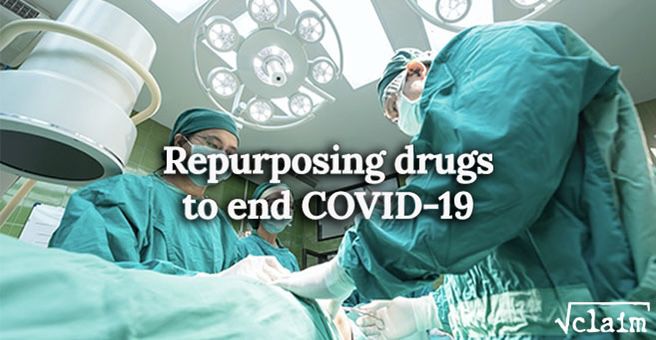The Problem
As the pandemic seemingly becomes endemic, two new, purpose-built drugs have just been FDA-approved. Pharmaceutical companies have been busy perfecting these new treatments, paxlovid and molnupiravir, almost since the pandemic began. The approval and roll-out of vaccines similarly took the better part of a year, on an expedited process no less. But the COVID-19 vaccines were an outlier, usually developing these purpose-built treatments takes years and can cost billions.
But waiting two years is too late. In a pandemic, a rapid response is paramount. Waiting for an effective, low-risk, purpose-built treatment that may only come in years will lead to innumerable deaths in the meantime, as happened during COVID-19.
So, under the constraints of a pandemic, the best way to save lives is to save time. Repurposing mobilizes already existing drugs with a known safety profile into the fight against the pandemic. Limiting ourselves to new drugs when a wealth of potential candidates already exists is extremely harmful. But repurposing does more than just provide a more efficient use of resources: deploying multiple drugs simultaneously limits opportunities for the virus to adapt as opposed to introducing each drug gradually.
The immediate question, then, is how to identify promising candidates and how to get them widely adopted. There are currently around 20 candidates for repurposing to combat COVID-19. Working out which are the most effective, and recommending them to the public, could end the COVID-19 pandemic.
Those who have read our ivermectin blog post will be familiar with the major stumbling block: no one in industry currently has the incentive to conduct repurposing trials and no one in government has the right combination of access to data and decision-making capacity to pursue a drug repurposing policy.
Existing Evidence
Despite the lack of incentives, some researchers did manage to conduct trials into drug repurposing for COVID-19. They had to run on shoe-string budgets, resulting in imperfect, flawed results. However, the resulting data is not useless, and careful analysis of all trial data can signal which repurposed drugs are likely enough to work.
There are around twenty candidates which have been discussed or trialled, including: vitamin D, fluvoxamine, antiandrogens, arginine, famotidine, melatonin, quercetin, vitamin K2, CoQ10, various mouthwashes and nasal sprays, nigella sativa and zinc lozenges. All have supporting studies, a strong biological rationale, or demonstrated effectiveness against similar viruses.
Of these, we find four to be the most promising as they have multiple independent sources signalling efficacy. This reduces the possibility of being wrong by only relying on one source, which may turn out to be false, either as a result of fraud, study flaws, or confounding factors. We estimate each treatment has over an 80% likelihood of being very effective, and they all carry near-zero risks. A protocol combining all of them is near certain to be highly effective, and may even end the pandemic.
Examples of signals of efficacy are: randomized controlled trials (RCT), a plausible mechanism of action, and a correlation between the use of the drug and COVID-19 severity. Especially interesting is a study on electronic health records (EHR) from Clalit health services (the largest health provider in Israel), which examined which purchases made in pharmacies were later associated with reduced severity. Only 41 drugs were found to be significantly protective, out of over 1000 examined, including all treatments below.
Fluvoxamine
Plausible mechanism of action:
- Fluvoxamine is a selective serotonin reuptake inhibitor (SSRI) antidepressant, hypothesized to have multiple mechanisms of action including an anti-inflammatory effect as an agonist for the sigma-1 receptor, reducing platelet aggregation, decreasing mast cell degranulation, and more.
Correlation studies
- In the Clalit study, patients purchasing escitalopram (another SSRI) were 17% less likely to later be hospitalized.
Randomized control trials
- An RCT found fluvoxamine to reduce hospital admissions by 35% and possibly cut deaths dramatically (1 versus 12 among those adhering to protocol).
Unlike other repurposing trials, this was a large-scale high-quality study, which received unanimous support from experts. - As fluvoxamine was already considered a promising candidate prior to this trial, this success validates the whole model, indicating there are many more effective treatments that are currently overlooked.
Vitamin D
Plausible mechanism of action:
- Vitamin D is an essential hormone of the immune system, and our modern indoor lifestyle causes many to be deficient in it. It is reasonable to assume that these deficiencies result in a suboptimal immune response to COVID-19.
- Additionally, it can promote autophagy, the process of replacing older cells with newer ones which can help fight infections better.
Correlation studies
- Prior to COVID, a meta-analysis of 25 RCTs found vitamin D supplementation to be protective against respiratory tract infections, especially among those deficient in it.
- In the Clalit study, patients buying vitamin D were 9-11% less likely to later be hospitalized.
Randomized control trials
- An RCT of 76 patients in Spain found that calcifediol (a more active form of vitamin D) dramatically reduced ICU admission and mortality. Of the 50 patients treated with calcifediol, 1 required an ICU compared with 13 of the 26 patients in the control group (a risk ratio of x25!). The trial had significant flaws but they are likely not enough to explain such a strong result.
Oral, ocular, and nasal disinfection
Plausible mechanism of action
- Virus replication is believed to start in these locations, and since they are regularly exposed to the outside world, they are able to survive disinfectants that would be too damaging in internal use. Regular disinfection of these areas is hypothesized to neutralize the virus before it expands into other organs and becomes uncontrollable.
Correlation studies:
- Impressively, 7 out of the 41 drugs identified in the Clalit study are related to eye hygiene.
Randomized control trials
- 10 RCTs have so far been published testing the disinfectant povidone-iodine. Assessed together, they show an overall improvement in symptoms at all stages of infection but are most effective when administered early (81% improvement).
- One RCT found that using iota-carrageenan nasal spray as prophylaxis reduced symptomatic cases by 80%.
- Most notably, one study tested simultaneous disinfection of the mouth, nose, and eyes, with povidone-iodine and showed an astounding 27-fold drop in patients who remained COVID positive after a week (70% vs 2.6%).
Antiandrogens
Plausible mechanism of action
- Antiandrogens are testosterone-blocking drugs, and reducing testosterone is known to reduce TMPRSS2, an enzyme that facilitates SARS-CoV-2 transmission.
Correlation studies
- Males are known to suffer from more severe COVID-19 outcomes.
- In the Clalit study, patients purchasing the antiandrogen dutasteride were 38% less likely to later be hospitalized.
Randomized control trials
- Patients receiving dutasteride reduced viral shedding, inflammatory responses, and time-to-remission.
- In a Brazilian study, females treated with proxalutamide were 84% less likely to be hospitalized. A similar study showed that males experienced a 91% drop when treated with the same drug. In another study it reduced mortality by 77.7%.
Rootclaim’s Proposal
We propose the establishment of an independent commission composed of medical and scientific experts with the remit to:
- Collect all research on repurposed drugs and contact researchers for clarifications.
- Determine the weaknesses and reliability of each study.
- Estimate the probability of efficacy of various repurposed treatments, considering different indicators of efficacy such as their mechanism of action, observational studies, and controlled trials.
- Assess the risks and interactions of each, relying on decades of real-world experience.
- Build protocols of repurposed treatments that best balance risks and benefits. Different protocols should be built, based on patient profiles and disease stages.
These recommendations should form the backbone for a two-front lobbying campaign to convince decision-makers and encourage public adoption.
For decision-makers:
- Lobby for adoption by public health authorities.
- Lobby decision-makers and politicians to support the initiative publicly.
For public and doctors:
- Familiarize doctors and nurses with the late-stage disease protocol.
- Familiarize GPs and family doctors with the early stage and preventative protocols.
- Public information campaigns to promote the initiative and reduce scepticism.
At surface level, our proposal seems fairly trivial: use the drugs we already have at our disposal, instead of focusing on developing new ones months or years down the line. Unfortunately, and with catastrophic consequences, implementing this obvious option is extremely difficult within the current incentive structure. But make no mistake – this is the most promising path out of the pandemic.


August 3, 2022 at 12:50 pm
Please read my story:
nancyrbenedict.Substack.com
We need an updated protocol with these drugs included. Thank you so much for your work.